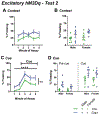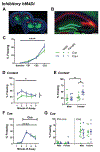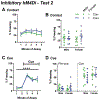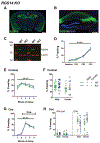Modulation of CA2 neuronal activity increases behavioral responses to fear conditioning in female mice
- PMID: 31319167
- PMCID: PMC6689262
- DOI: 10.1016/j.nlm.2019.107044
Modulation of CA2 neuronal activity increases behavioral responses to fear conditioning in female mice
Abstract
Activity of hippocampal pyramidal cells is critical for certain forms of learning and memory, and work from our lab and others has shown that CA2 neuronal activity is required for social cognition and behavior. Silencing of CA2 neurons in mice impairs social memory, and mice lacking Regulator of G-Protein Signaling 14 (RGS14), a protein that is highly enriched in CA2 neurons, learn faster than wild types in the Morris water maze spatial memory test. Although the enhanced spatial learning abilities of the RGS14 KO mice suggest a role for CA2 neurons in at least one hippocampus-dependent behavior, the role of CA2 neurons in fear conditioning, which requires activity of hippocampus, amygdala, and possibly prefrontal cortex is unknown. In this study, we expressed excitatory or inhibitory DREADDs in CA2 neurons and administered CNO before the shock-tone-context pairing. On subsequent days, we measured freezing behavior in the same context but without the tone (contextual fear) or in a new context but in the presence of the tone (cued fear). We found that increasing CA2 neuronal activity with excitatory DREADDs during training resulted in increased freezing during the cued fear tests in males and females. Surprisingly, we found that only females showed increased freezing during the contextual fear memory tests. Using inhibitory DREADDs, we found that inhibiting CA2 neuronal activity during the training phase also resulted in increased freezing in females during the subsequent contextual fear memory test. Finally, we tested fear conditioning in RGS14 KO mice and found that female KO mice had increased freezing on the cued fear memory test. These three separate lines of evidence suggest that CA2 neurons are actively involved in both intra- and extra-hippocampal brain processes and function to influence fear memory. Finally, the intriguing and consistent findings of enhanced fear conditioning only among females is strongly suggestive of a sexual dimorphism in CA2-linked circuits.
Keywords: Amygdala; DREADD; Fear conditioning; Hippocampal CA2; RGS14; hM3Dq; hM4Di.
Published by Elsevier Inc.
Conflict of interest statement
Figures






References
-
- Balogh SA, & Wehner JM (2003). Inbred mouse strain differences in the establishment of long-term fear memory. Behavioural Brain Research, 140(1-2), 97–106. - PubMed
Publication types
MeSH terms
Substances
Grants and funding
LinkOut - more resources
Full Text Sources
Research Materials
Miscellaneous

